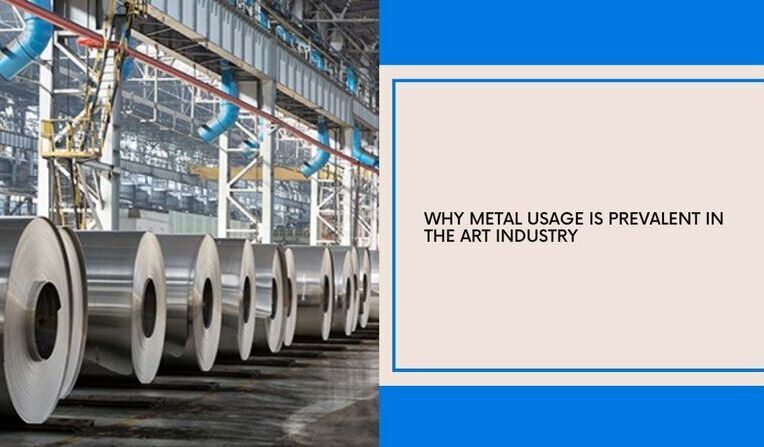12 Reasons Why Metal Usage Is Prevalent In The Art Industry

For their versatility, durability, and aesthetic appeal, society has cherished metals for a long – making them a cornerstone in the art and design realm. The use of metals in artistic expressions: from ancient sculptures to contemporary architectural marvels; this evolution not only shapes our physical world but also influences how we perceive it–and interact with it as well.
1. The Timeless Allure of Metal Art
Ancient civilizations, dating back to a time when bronze and iron were available, crafted these materials into intricate sculptures and decorative items. Not only did these early works serve functional purposes; but they also communicated cultural narratives — religious stories included — and societal values: thus revealing the rich history of metal art at its inception.
2. Sculpting with Metal
Across varied eras, sculptors have actively leveraged the malleability and strength of metals: their masterpieces—primarily composed of bronze, copper, and steel—are timeless symbols that embody human creativity. Adorning public spaces; museums; private collections–each sculpture narrates a distinct story through an artist’s vision.
Artists often utilize cold rolled steel when aiming for intricate patterns or textures in their designs. The material’s smooth surface readily accepts engraving, embossing, or other texturing techniques, enabling the creation of visually captivating and tactile artworks.
3. Jewelry as Wearable Metal Art
Metallurgy’s art extends into personal adornment, transforming precious metals such as gold and silver into intricate jewelry. These wearables not only exhibit craftsmanship but also carry cultural and sentimental value that subsequent generations inherit.
4. Contemporary Metal Design
Metal design in the modern era transcends traditional boundaries: it gives rise to avant-garde structures; furniture and functional art pieces–all crafted with metals. Architects, specifically utilizing stainless steel and aluminum, engineer sleek futuristic designs that effectively marry aesthetics with functionality.
5. Architectural Marvels in Metal
Metals in architecture have revolutionized building conception and construction, as iconic structures such as the Eiffel Tower or Walt Disney Concert Hall exemplify. These masterpieces showcase not only metals’ beauty but also their structural integrity, thereby stretching architectural imagination to new limits.
6. Metalworking Techniques
A myriad of metalworking techniques: welding, forging, casting and engraving–these are just a few examples; artisans expertly employ them to shape and manipulate metals into their desired forms. In metal art specifically, these craftsmen use intricate patterns as well as textures – all part of the design process.
7. Functional Metal Art
Metal, beyond mere aesthetics, finds escalating integration into functional art pieces: these serve practical purposes. Furniture; lighting fixtures–even home décor items exemplify the harmonious union of form and utility without sacrificing artistic expression.
8. Public Art Installations
Large-scale metal art installations captivate and inspire public spaces worldwide, often transforming urban environments into open-air galleries. These sculptures adorn the landscape as landmarks, inviting passersby for interaction and contemplation.
9. Customization and Personalization
Metals’ versatility empowers artists and designers to customize pieces according to unique preferences: from personalized jewelry – an intimate expression of identity – to bespoke metal furniture. This process of customization imbues the artwork with a distinct touch, cultivating a profound connection between it and its owner.
10. Pushing Boundaries with Mixed Media
Frequently, contemporary artists rigorously probe mixed media: metals entwine with materials such as glass; wood collides — or indeed, ceramics are integrated. This amalgamation of elements introduces intricate layers to both art and design; it fosters creations that boldly challenge conventional categorizations.
11. Sustainability in Metal Art
Artists and designers, as environmental consciousness expands, embrace sustainable practices in metalworking; they recycle and repurpose metals to contribute towards eco-friendly art. This aligns–through a global shift–with responsible creativity that is also sustainable.
12. Metal Art as Investment
Particularly for collectors, the intrinsic value of certain metals – like gold and silver – transforms metal art into an investment. Unique sculptures, artifacts, and jewelry may appreciate over time; this appreciation not only enhances their aesthetic appeal but also infuses them with financial worth.
Conclusively, metals in art and design bear witness to human creativity, innovation, and the persistent charm of craftsmanship. Metalsmiths shape our environment with sculptural masterpieces or functional furniture pieces; they even etch personal jewelry items—all offering an amalgamation of aesthetics, functionality, and cultural importance. Anticipating a perpetual evolution of this ancient medium—reflecting not only each era’s spirit but also the dynamic landscape of human expression—as artists unceasingly test metals’ boundaries is inevitable.

Pranab Bhandari is an Editor of the Financial Blog “Financebuzz”. Apart from writing informative financial articles for his blog, he is a regular contributor to many national and international publications namely Tweak Your Biz, Growth Rocks ETC.







